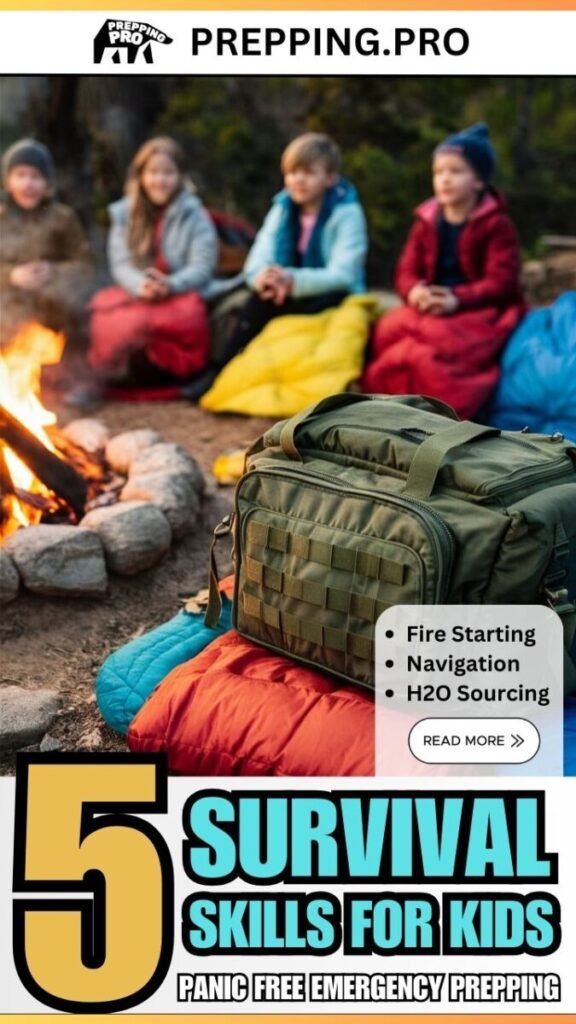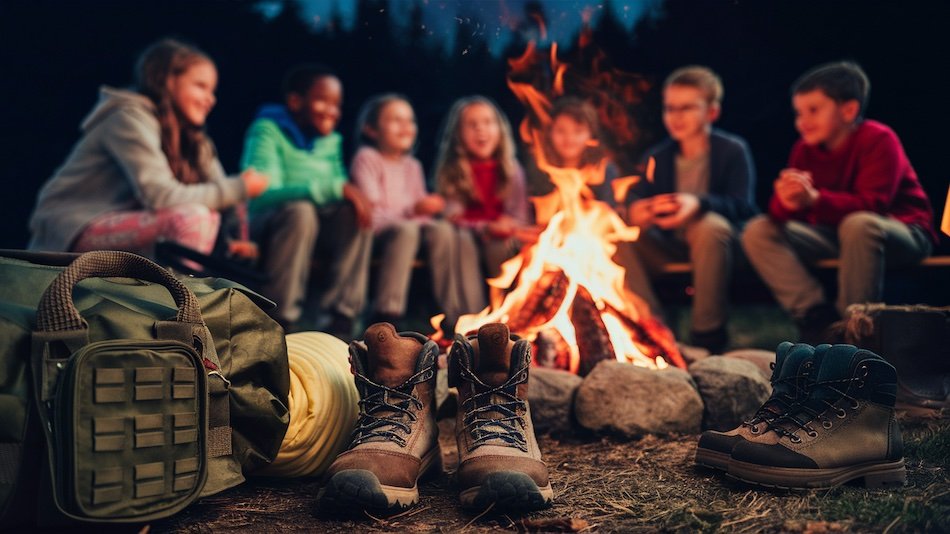Teaching your children essential survival skills is not just about preparing them for worst-case scenarios—it’s about instilling confidence, self-reliance, and a deep connection with nature.
In this comprehensive guide, we’ll explore eight crucial survival skills for kids that every parent should teach their children. These skills will not only equip them for outdoor adventures but also provide valuable life lessons that will serve them well into adulthood.

Key Takeaways:
By mastering these survival skills for kids, your children will learn how to navigate without a compass, build shelters, find and purify water, start fires safely, and identify edible plants in the wild—essential knowledge that could one day save their lives or the lives of others.
Table of Contents
1. Basic Fire Starting Techniques
Fire starting is a fundamental survival skill for kids to master.
The ability to create fire provides warmth, light, and a means to purify water and cook food in emergency situations.
Learning various methods to start a fire is essential for young survivalists.
Gathering Tinder and Kindling
Children should learn to identify and collect dry materials for fire starting.
Tinder includes easily ignitable items like dry grass, paper, or bark fibers.
Kindling consists of small twigs and sticks that catch fire quickly.
Using Matches and Lighters Safely
Teach kids the proper handling of matches and lighters, emphasizing safety precautions.
Demonstrate how to strike a match away from the body and dispose of used matches responsibly.
Alternative Fire-Starting Methods
Introduce children to alternative methods such as using a ferro rod or magnifying glass. These techniques enhance their wilderness survival for children skills and provide options when conventional methods aren’t available.
For advanced techniques, consider teaching them the bow drill fire starting method or the fire plow technique.
| Fire Starting Method | Difficulty Level | Materials Needed |
|---|---|---|
| Matches | Easy | Matches, tinder |
| Lighter | Easy | Lighter, tinder |
| Ferro Rod | Moderate | Ferro rod, striker, tinder |
| Magnifying Glass | Moderate | Magnifying glass, dry tinder, sunlight |
Action points for teaching fire starting:
- Practice fire safety rules and responsible fire management
- Conduct supervised fire-starting sessions in a controlled environment
- Teach children to extinguish fires properly and leave no trace
For more advanced fire-starting skills, explore campfire mastery techniques and learn how to build a fire with wet wood or in snow conditions.
2. Water Sourcing and Purification
Access to clean water is essential for survival.
Outdoor emergency preparedness for kids includes knowing how to find and purify water in the wilderness.
Identifying Safe Water Sources in the Wild
Teach children to locate potential water sources such as streams, rivers, and springs.
Explain the importance of moving water and how to assess water clarity.
Simple Water Purification Methods
Introduce kids to various purification techniques, including boiling, chemical treatments, and filtration.
Explain the risks of drinking untreated water and the importance of purification.
Importance of Staying Hydrated
Stress the critical role of hydration in survival situations. Teach children to recognize signs of dehydration and understand how much water they need to consume daily.
| Water Purification Method | Effectiveness | Time Required |
|---|---|---|
| Boiling | High | 5-10 minutes |
| Chemical Treatment (Iodine/Chlorine) | High | 30 minutes |
| Filtration | Moderate to High | Immediate |
| Solar Disinfection (SODIS) | Moderate | 6 hours to 2 days |
Action points for water sourcing and purification:
- Practice identifying water sources during nature walks
- Demonstrate various purification methods in a controlled setting
- Create a mini water treatment station for hands-on learning
3. Shelter Building for Young Adventurers
Shelter building is a crucial backwoods skill for young adventurers.
A proper shelter protects from the elements and provides a sense of security in survival situations.
Learn about survival shelters for beginners to get started.
Natural Shelter Options
Teach kids to identify natural shelter options such as caves, large fallen trees, or rock overhangs.
Explain the advantages and potential risks of each type of natural shelter.
For more ideas, explore natural shelters that can be easily constructed.
Basic Shelter Construction Techniques
Introduce children to simple shelter designs like lean-tos, debris huts, and A-frame shelters.
Guide them through the process of gathering materials and constructing these shelters.
For a quick and easy option, learn how to build a tarp shelter.
Selecting Safe Locations for Shelter
Educate young adventurers on choosing appropriate shelter locations.
Factors to consider include protection from wind, proximity to water, and avoiding areas prone to falling branches or flooding.
| Shelter Type | Difficulty Level | Materials Needed |
|---|---|---|
| Lean-to | Easy | Long branch, smaller branches, leaves/debris |
| Debris Hut | Moderate | Long branch, smaller branches, leaves/debris |
| A-frame | Moderate | Two long branches, smaller branches, cordage |
| Snow Cave | Advanced | Snow, shovel or improvised digging tool |
Action points for shelter building:
- Organize shelter-building competitions in a safe outdoor area
- Teach children to assess and choose suitable shelter locations
- Practice building different types of shelters using various materials
For more advanced shelter-building techniques, check out simple tarp shelters that can be easily constructed in various environments.
4. Navigation and Orienteering Skills
Navigation is a vital survival skill for kids that enhances their confidence in the outdoors.
These skills help children find their way and avoid getting lost in unfamiliar terrain.
Learn how to navigate without a compass for additional techniques.
Reading Maps and Using a Compass
Teach kids how to read topographic maps and use a compass.
Start with basic concepts like cardinal directions and gradually introduce more complex skills like triangulation.
For a comprehensive guide, explore map reading mastery.
Natural Navigation Methods
Introduce children to natural navigation techniques using the sun, stars, and environmental cues.
These skills provide backup options when modern tools are unavailable.
GPS Basics for Kids
Familiarize young adventurers with GPS devices and smartphone navigation apps.
Teach them how to input coordinates, mark waypoints, and follow routes.
| Navigation Method | Reliability | Skills Required |
|---|---|---|
| Map and Compass | High | Map reading, compass use |
| Natural Navigation | Moderate | Observational skills, knowledge of natural indicators |
| GPS | High (when functioning) | Basic technology skills, understanding of coordinates |
| Smartphone Apps | Moderate (battery dependent) | Basic technology skills, app familiarity |
Action points for navigation and orienteering:
- Organize orienteering games and scavenger hunts to practice skills
- Teach children to create and follow simple maps of familiar areas
- Practice using both traditional and modern navigation tools during outdoor trips
5. Foraging and Wild Edibles Identification
Foraging is an important wilderness survival for children skill that can provide sustenance in emergency situations.
Teaching kids to identify edible plants enhances their connection with nature and promotes self-reliance.
Safe Plants to Eat in Your Region
Introduce children to common edible plants in your area.
Focus on easily identifiable species with distinct characteristics to minimize the risk of misidentification.
For a comprehensive guide, check out edible wild plants.
Avoiding Poisonous Plants
Teach kids to recognize poisonous plants common to your region.
Emphasize the importance of absolute certainty before consuming any wild plant.
Sustainable Foraging Practices
Educate young foragers on ethical and sustainable harvesting techniques.
Teach them to take only what they need and to preserve plant populations for future growth.
| Edible Plant | Identifying Features | Edible Parts |
|---|---|---|
| Dandelion | Yellow flower, toothed leaves | Leaves, flowers, roots |
| Blackberry | Thorny stems, white flowers, black berries | Berries, young leaves |
| Cattail | Tall stalks, brown cigar-shaped heads | Shoots, pollen heads, roots |
| Chickweed | Small white flowers, oval leaves | Leaves, stems, flowers |
Action points for foraging and wild edibles:
- Conduct guided nature walks to identify edible and poisonous plants
- Create a foraging journal with drawings and descriptions of local plants
- Practice sustainable harvesting techniques in a controlled environment
For additional foraging skills, learn about foraging for pet food to ensure the well-being of your furry companions in survival situations.
Conclusion
By mastering these five essential areas of survival skills for kids, children will be well-equipped to handle a wide range of outdoor challenges and emergency situations.
Regular practice, hands-on experience, and ongoing education will reinforce these skills, building confidence and competence in young adventurers.
Remember to adapt the instruction to each child’s age and abilities, always prioritizing safety and responsible outdoor practices.
Incorporating these skills into family activities and outdoor excursions will foster a lifelong appreciation for nature, self-reliance, and emergency preparedness in your children.
For more comprehensive survival training, consider exploring camping and survival skills for kids and survival training for kids to further enhance their outdoor capabilities.


